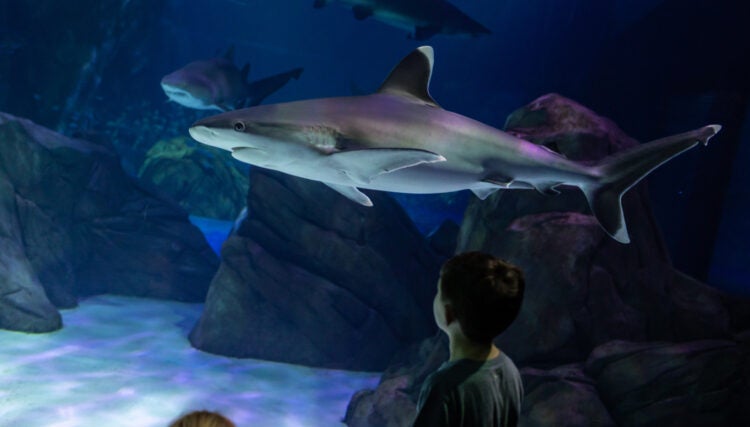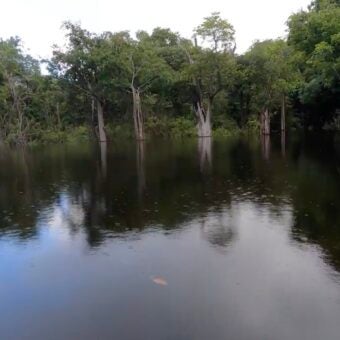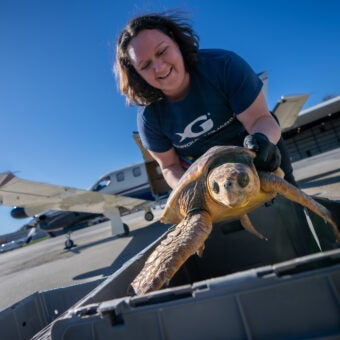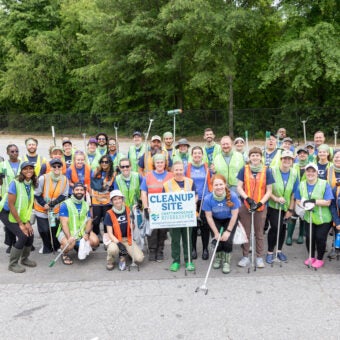PINE KNOLL SHORES, N.C. – Less than a year after the North Carolina Aquariums launched Spot A Shark USA, a citizen science program, lead researchers have issued initial findings in a manuscript published in the journal “Ecology” today. The four-page document outlines a discovery that could play a significant role in the strategic protection of the sand tiger shark, Carcharias taurus, a globally designated vulnerable species, whose presence is linked to healthy aquatic ecosystems.
“Photographs collected by citizen scientists revealed that a large coastal shark species, the sand tiger shark, returns to the same or nearby shipwrecks,” said Avery Paxton, lead researcher for the project and principal author of the paper. “This behavior, known as site fidelity, could mean shipwrecks play a significant role in the lives of this imperiled shark species.”
The preliminary findings add to a growing body of evidence that shipwrecks are potentially critical habitat for the species and could help facilitate conservation of sand tiger sharks, whose U.S. populations have been estimated to have declined by more than 75 percent primarily in the 1980s and 1990s.
“This manuscript is an introductory representation of the larger body of work that’s developing around sand tiger sharks and habitat use on sites along the coast of North Carolina,” said Hap Fatzinger, director of the North Carolina Aquarium at Fort Fisher. “The larger body of work, utilizing acoustic telemetry work and expansion of the Spot A Shark USA data set, will reveal the bigger picture over time.”
It is believed this highly migratory species uses the North Carolina wrecks as “rest stops” on their journey from New England to Florida. Another hypothesis suggests the shipwrecks may be even more valuable to sand tigers. The shipwrecks could be key reproductive habitats or year-round habitats.
That’s what makes citizen scientists so important. The area is so vast and there is no way researchers could cover that much ground, said Paxton, a visiting scholar at Duke University Marine Lab.
Divers submit both new and historical images to the Spot A Shark USA website giving as much information about the image as possible. Behind the scenes researchers map the spots of each shark to identify them uniquely, much like a human can be identified by a finger print.
“Six female sand tiger sharks were photographed and re-photographed at the same or nearby shipwrecks located off the coast of North Carolina over a period of time ranging from a few months to six years,” said Paxton, formerly a postdoctoral researcher with the South-East Zoo Alliance for Reproduction & Conservation. “This indicates shipwrecks are potentially critical habitats for sand tiger sharks and worthy of further research.”
These findings are similar to research along the eastern Australia coast and in offshore waters of South Africa, which shows “sand tiger sharks exhibit high site fidelity on offshore reefs as juveniles and adults,” Paxton said.
“There are still a lot of unknowns,” Paxton said. “We do not know what the female sand tigers are doing in between the times they are photographed. We also do not know what the males are doing. That does not mean that the males do not also return to the same or nearby shipwrecks, rather they have not been photographed doing so.
“It is a scientific process, and we have just started chipping at the surface,” said Paxton. “That’s why it is so important to share this information to further future research efforts.”
The North Carolina Aquariums led collaboration includes Georgia Aquarium, Minnesota Zoo Foundation, Maritime Aquarium at Norwalk, New York Aquarium, Wildlife Conservation Society, South-East Zoo Alliance for Reproduction & Conservation, Duke University, University of North Carolina at Chapel Hill, University of North Carolina Wilmington, East Carolina University, Coastal Studies Institute, Wild Me, Blue Elements Imaging, and most importantly the citizen scientists who are submitting photos.
Bringing researchers and divers from around the world to the table is crucial to solving the complex mysteries of the sand tiger shark and facilitating conservation and ultimately the recovery of this iconic species.
“The North Carolina Aquariums are proud to lead a multi-institutional effort to better understand how sand tiger sharks are using habitats along the coast of North Carolina. Through collaborations and strong partnerships, Spot A Shark USA is engaging recreational divers to become citizen scientists and provide essential data to expand our knowledge,” said Fatzinger. “By increasing community engagement, we are creating stronger connections to local, regional and global concerns for sharks and healthy ocean ecosystems.”
For the full manuscript DOI: 10.1002/ecy.2687, visit the online library here.
This article was published on: June 25, 2019
Georgia Aquarium is one of the largest aquariums in the world with more than 11 million gallons of water and tens of thousands of animals. Located in Atlanta, Ga., it is a premier animal care and research facility that is accredited by the Association of Zoos and Aquarium, the Alliance of Marine Mammal Parks and Attractions, Humane Certified by American Humane, and a Class R research institution certified by the USDA. By providing guests with unparalleled opportunities to learn about marine life, Georgia Aquarium is dedicated to unlocking the ocean’s wonder for all, providing transformative experiences that inspire a shared responsibility for conserving our aquatic ecosystems.






